Excerpts from Jim Conrad's
Naturalist Newsletter
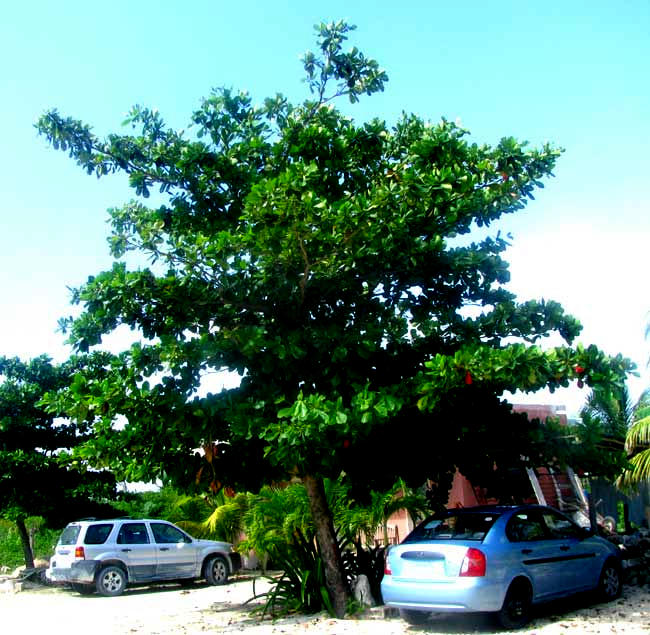
from the November 6, 2006 Newsletter issued from Genesis Retreat near Ek Balam, Yucatán, México
TROPICAL ALMOND TREE
Throughout the world's tropics when you see a street tree with big, blackjack-shaped leaves and the branches are arranged so that they appear to be in layers separated from one another by shadowy space -- as in the above picture taken on a Caribbean beach -- a good bet is that it's the Tropical Almond, TERMINALIA CATAPPA, a member of the mostly tropical Combretum Family. Though common throughout tropical Mexico, including next to huts in Ek Balam, the species originally is from Madagascar, Malaya and the East Indies.
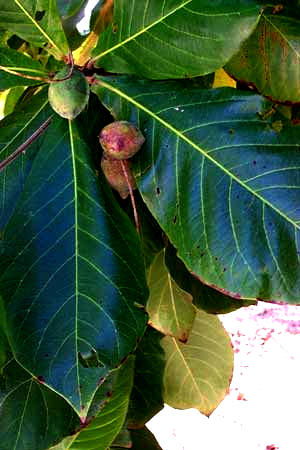
As the picture at the right shows, though the "almonds" look a lot like the almonds grown up North -- with a thin, leathery husk and a hard, woody "nut" inside containing an edible seed, which tastes more or less like the Northern almond, Tropical Almonds and Northern almonds are in entirely different plant families. Northern almonds are members of the Rose Family, and are very closely related to plums, cherries and peaches. Tropical Almonds are more closely related to Blackgum Trees and eucalyptuses.
Beneath the tree pictured above the ground was strewn with tropical almonds, but no one seemed interested in picking them up. One reason might be that the seed coat is pretty hard. You have to struggle a bit to get the "almond." However, the kernel is tasty and nutritious, worth knowing about when the infrastructure collapses.
from the October 2, 2011 Newsletter issued from Mayan Beach Garden Inn 20 kms north of Mahahual; Caribbean coastal beach and mangroves, ~N18.89°, ~W87.64°, Quintana Roo state, MÉXICO
TROPICAL ALMONDS FLOWERING
A Tropical Almond's leaves and long, slender flower spikes (±8 inches, 20cm) are shown below:
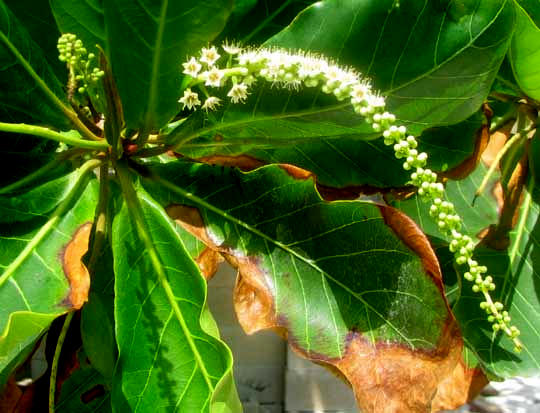
A close-up of a single flower showing five whitish calyx lobes (no petals), ten stamens, and a fingerlike style arising from the flower's center amidst many outward-pointing hairs is shown below:
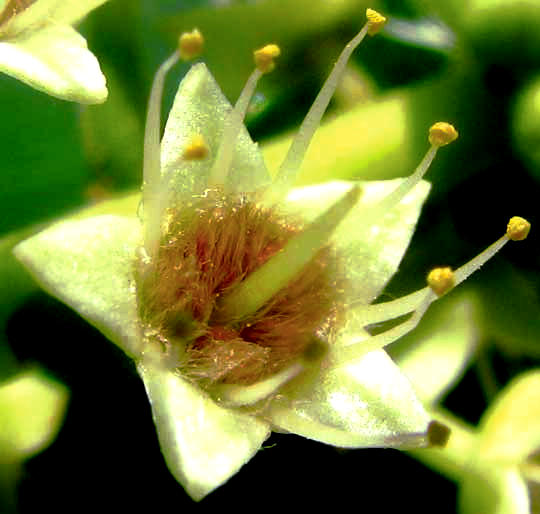
I'm guessing that the hairs dissuade insects from entering the blossom to eat the ovary (future fruit) exposed at the flower's base.
The flower in our picture bears both male and female parts. The ten pollen-producing stamens are the male parts, and the slender style in the center is the female ovary's "neck," atop which -- on the stigmatic area -- pollen from other flowers will germinate. Most flowers in the spike are strictly male but a few female flowers, which in the end will produce fruits, cluster toward the spike's base. A study in Florida found that most Tropical Almond flower spikes bore about sixteen times more male flowers -- flowers bearing only stamens, with no ovary and style -- than "hermaphroditic" flowers bearing both male and female parts.
*****
from the October 2, 2011 Newsletter issued from Mayan Beach Garden Resort 20 kms north of Mahahual; Caribbean coastal beach and mangroves, ~N18.89°, ~W87.64°, Quintana Roo state, MÉXICO
EATING TROPICAL ALMOND
Tropical Almonds are NOT closely related to the North's Almond trees. Northern Almonds are members of the Rose Family while Tropical Almonds belong to the Combretum Family, the Combretaceae, a family little known in the North, and allied with the myrtles.
Despite their not being related, Tropical Almond fruits are a lot like northern Almonds.
Beneath any mature Tropical Almond tree usually you can find some rather shaggy, often dirty looking, "almond-shaped" fruits. They're shaggy because the seeds are encased in a fibrous husk so tough that the fruits can lie around for weeks or months being trod upon, gathering dinginess. As with northern Almonds, to get to the edible kernel you need to break open the seed inside the fibrous husk. And that seed is very hard.
My Maya friends who grew up playing "crack-the-tropical-almond-nut" make cracking the nut with a big rock look easy, but it's not. If a beginner cracks the nut at all, usually the kernel ends up so smashed and mingled with dirty husk and shattered rock that it's useless. Nevertheless, it can be done, as shown below:
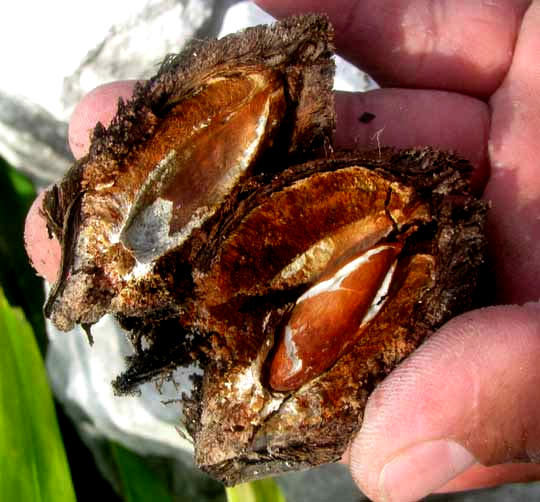
That picture shows a perfectly cracked fruit in the hands of my Maya friend, Martín, who cracked it. The edible kernel is the rusty-colored item nestled in a cavity in the right half of the fruit.
That kernel looks like a northern almond, tastes like one, and has a similar texture and oiliness. A paper on the Internet reports Tropical Almond seeds as containing 24% crude protein and goodly amounts of minerals, especially potassium. Oil expressed from the seeds contained high levels of unsaturated fatty acids, and that's the good kind.
So, Tropical Almond seeds are good to eat and in most towns and villages in our area they're free for the having. The problem is getting through that hard shell.
from the February 7, 2016 Newsletter issued from Hacienda Chichen Resort beside Chichén Itzá Ruins, central Yucatán MÉXICO
TROPICAL ALMOND'S REDDENING LEAVES
Here during the early dry season many of our native trees as well as some introduced ones are losing their leaves, or are already completely leafless. The leaf drop is to conserve water during the upcoming rainless months, for leaves transpire water, even leathery, waxy-surfaced ones adapted for arid environments.
The Hacienda's Tropical Almond trees haven't lost their leaves yet, but their big, club-shaped leaves are turning red in preparation for it. The red leaves add a touch of fallishness to the landscape, even as other dry-season-leafless trees look wintry, and other dark, green, broadleaf-evergreen trees look summery. Below, you can see what a gathering of red-turning Tropical Almond tree leaves looks like on a sunny day with a blue-sky background:
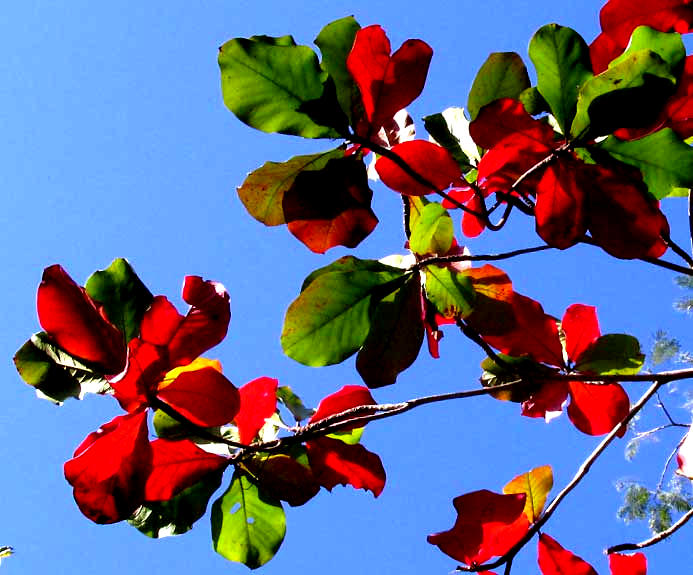
Even among our introduced ornamental trees, such spectacular outbreaks of bright red leaves are rare around here. Their brilliance got me to wondering if there might be something special going on.
I learned that Tropical Almond leaves are describe as "chemically rich," and that they're used in many different herbal medicines for various purposes. The most frequently mentioned medicinal use is against dysentery and diarrhea in humans, and among tropical fish breeders in tropical countries often leaves are placed in the water to deal with fish parasites and bacterial pathogens. For a healthy aquarium, for each 100 liters of water, add three or four leaves in the water for four or five days. The online Agroforestry Database 4.0 mentions the red leaves can serve as a vermifuge -- against intestinal worms.
Though the leaves contain many compounds -- flavonoids, saponines, phytosterols and many tannins, I suspect that the bitter tannins provide most medicinal benefit, for they're astringent and cause tissue to pucker, which can seem useful during bouts of diarrhea. Tropical Almond's bark is especially high in tannins. The Agroforestry Database reports bark containing 9-23% tannin, which is pretty high.